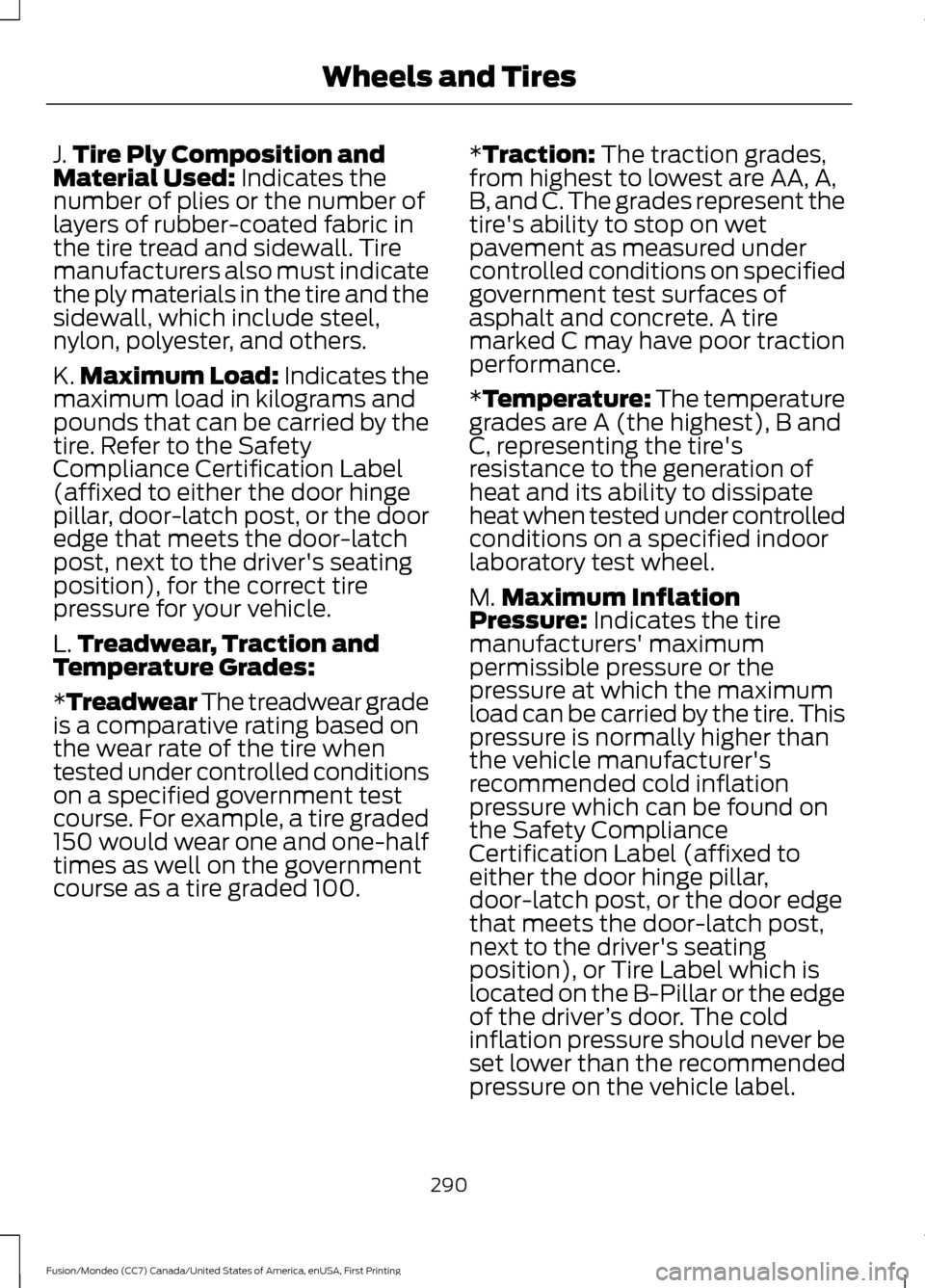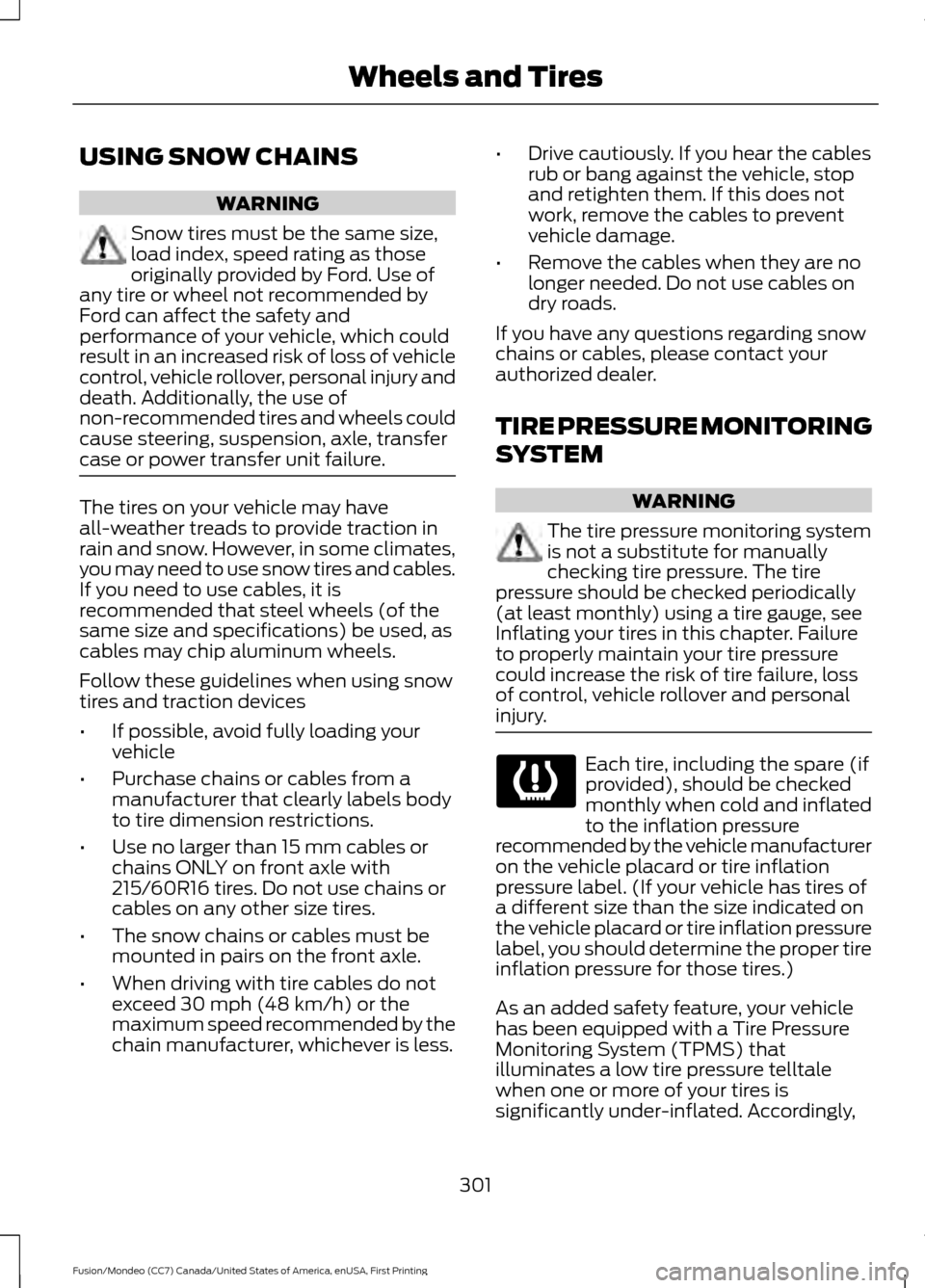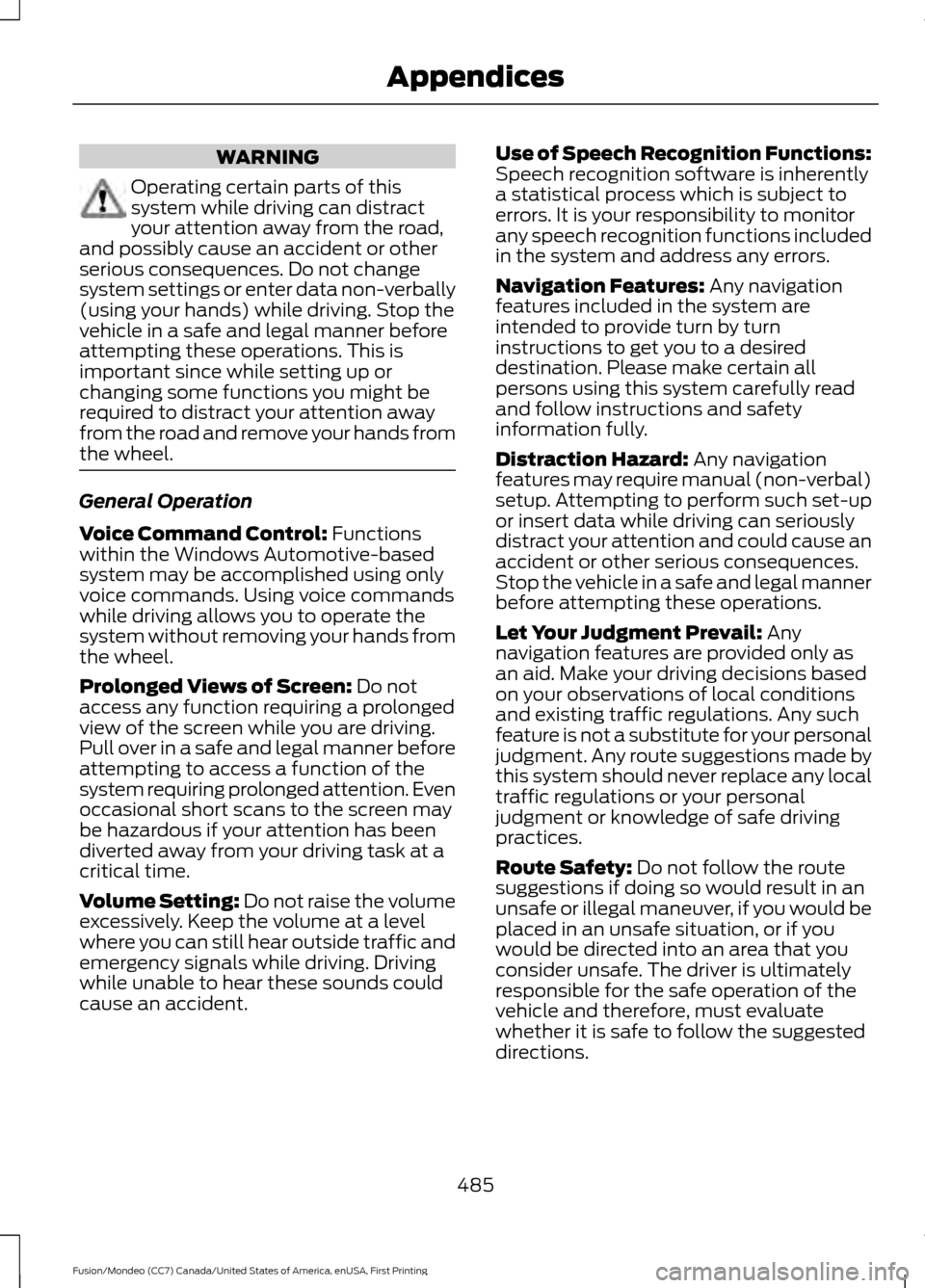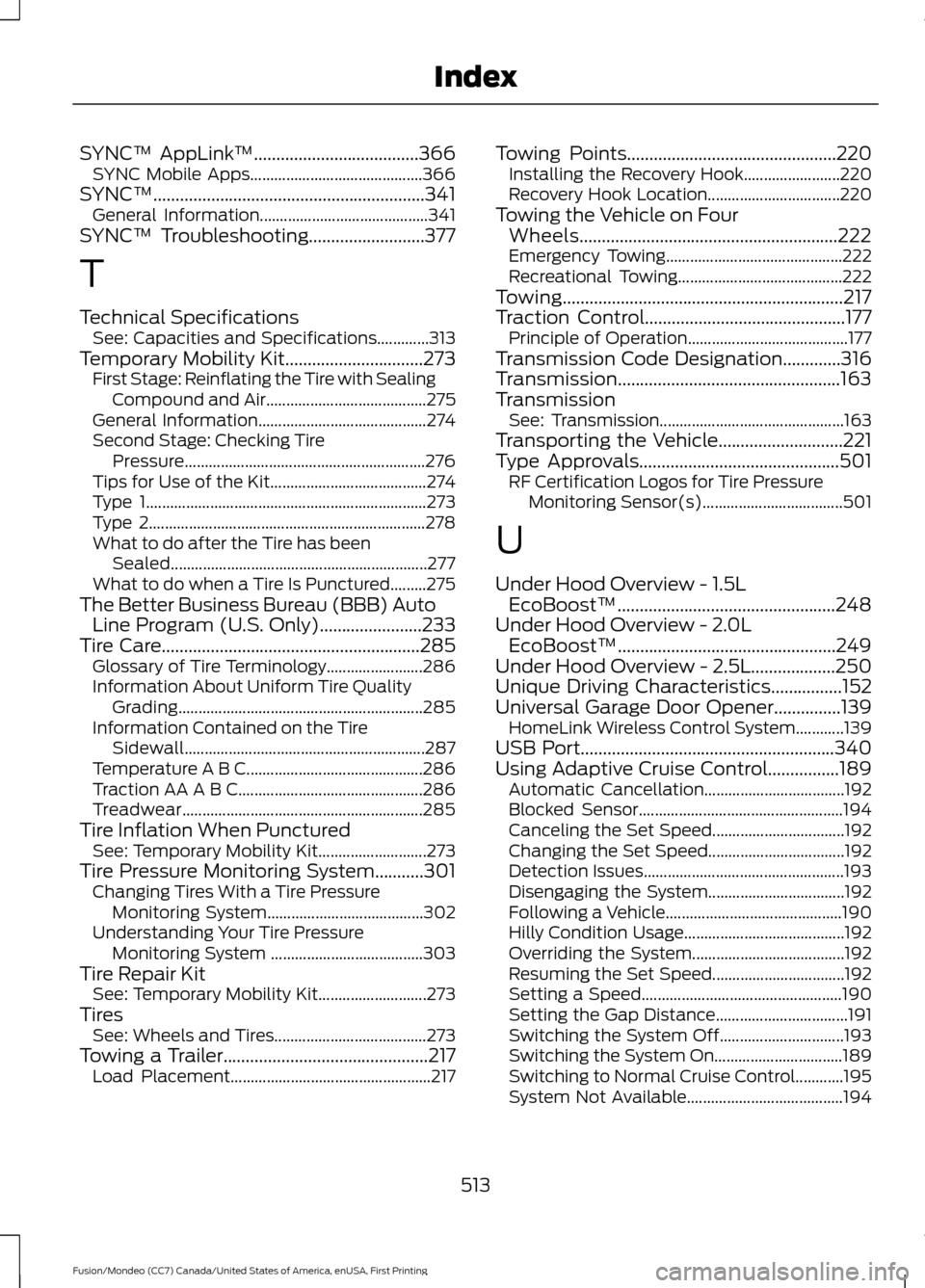2016 FORD FUSION (AMERICAS) traction control
[x] Cancel search: traction controlPage 288 of 518

TIRE CARE
Important information for
235/40R19 low-profile tires
and wheels If your vehicle is
equipped with 235/40R19 tires,
they are low-profile tires. These
tires and wheels are designed to
give your vehicle a sport
appearance. With low-profile tires,
you may notice an increase in road
noise and faster tire wear,
depending on road conditions and
driving styles. Due to their design,
low-profile tires and wheels are
more prone to road damage from
potholes, rough or unpaved roads,
car wash rails and curb contact
than standard tires and wheels.
Note: Your vehicle ’s warranty does
not cover these types of damage.
Tires should always be kept at the
correct inflation pressures and
extra caution should be taken when
operating on rough roads to avoid
impacts that could cause wheel
and tire damage.
Information About Uniform
Tire Quality Grading Tire Quality Grades apply to new
pneumatic passenger car tires.
The Quality grades can be found
where applicable on the tire
sidewall between tread shoulder
and maximum section width. For
example:
Treadwear 200
Traction AA Temperature A.
These Tire Quality Grades are
determined by standards that the
United States Department of
Transportation has set.
Tire Quality Grades apply to new
pneumatic passenger car tires.
They do not apply to deep tread,
winter-type snow tires,
space-saver or temporary use
spare tires, light truck or LT type
tires, tires with nominal rim
diameters of 10 to 12 inches or
limited production tires as defined
in Title 49 Code of Federal
Regulations Part 575.104 (c)(2).
U.S. Department of
Transportation Tire quality
grades:
The U.S. Department of
Transportation requires Ford
Motor Company to give you the
following information about tire
grades exactly as the government
has written it.
Treadwear
The treadwear grade is a
comparative rating based on the
wear rate of the tire when tested
under controlled conditions on a
specified government test course.
For example, a tire graded 150
would wear 1 ½ times as well on
285
Fusion/Mondeo (CC7) Canada/United States of America, enUSA, First Printing Wheels and TiresE142542
Page 289 of 518

the government course as a tire
graded 100. The relative
performance of tires depends
upon the actual conditions of their
use, however, and may depart
significantly from the norm due to
variations in driving habits, service
practices, and differences in road
characteristics and climate.
Traction AA A B C
WARNING
The traction grade assigned
to this tire is based on
straight-ahead braking traction
tests, and does not include
acceleration, cornering,
hydroplaning or peak traction
characteristics. The traction grades, from highest
to lowest are AA, A, B, and C. The
grades represent the tire
’s ability
to stop on wet pavement as
measured under controlled
conditions on specified
government test surfaces of
asphalt and concrete. A tire
marked C may have poor traction
performance. Temperature A B C WARNING
The temperature grade for
this tire is established for a
tire that is properly inflated and
not overloaded. Excessive speed,
underinflation, or excessive
loading, either separately or in
combination, can cause heat
buildup and possible tire failure. The temperature grades are A
(the highest), B and C,
representing the tire
’s resistance
to the generation of heat and its
ability to dissipate heat when
tested under controlled conditions
on a specified indoor laboratory
test wheel. Sustained high
temperature can cause the
material of the tire to degenerate
and reduce tire life, and excessive
temperature can lead to sudden
tire failure. The grade C
corresponds to a level of
performance which all passenger
car tires must meet under the
Federal Motor Vehicle Safety
Standard No. 139. Grades B and A
represent higher levels of
performance on the laboratory
test wheel than the minimum
required by law.
Glossary of Tire Terminology
* Tire label: A label showing the
original equipment tire sizes,
recommended inflation pressure
and the maximum weight the
vehicle can carry.
286
Fusion/Mondeo (CC7) Canada/United States of America, enUSA, First Printing Wheels and Tires
Page 293 of 518

J.
Tire Ply Composition and
Material Used: Indicates the
number of plies or the number of
layers of rubber-coated fabric in
the tire tread and sidewall. Tire
manufacturers also must indicate
the ply materials in the tire and the
sidewall, which include steel,
nylon, polyester, and others.
K. Maximum Load: Indicates the
maximum load in kilograms and
pounds that can be carried by the
tire. Refer to the Safety
Compliance Certification Label
(affixed to either the door hinge
pillar, door-latch post, or the door
edge that meets the door-latch
post, next to the driver's seating
position), for the correct tire
pressure for your vehicle.
L. Treadwear, Traction and
Temperature Grades:
*Treadwear The treadwear grade
is a comparative rating based on
the wear rate of the tire when
tested under controlled conditions
on a specified government test
course. For example, a tire graded
150 would wear one and one-half
times as well on the government
course as a tire graded 100. *Traction: The traction grades,
from highest to lowest are AA, A,
B, and C. The grades represent the
tire's ability to stop on wet
pavement as measured under
controlled conditions on specified
government test surfaces of
asphalt and concrete. A tire
marked C may have poor traction
performance.
*
Temperature: The temperature
grades are A (the highest), B and
C, representing the tire's
resistance to the generation of
heat and its ability to dissipate
heat when tested under controlled
conditions on a specified indoor
laboratory test wheel.
M. Maximum Inflation
Pressure:
Indicates the tire
manufacturers' maximum
permissible pressure or the
pressure at which the maximum
load can be carried by the tire. This
pressure is normally higher than
the vehicle manufacturer's
recommended cold inflation
pressure which can be found on
the Safety Compliance
Certification Label (affixed to
either the door hinge pillar,
door-latch post, or the door edge
that meets the door-latch post,
next to the driver's seating
position), or Tire Label which is
located on the B-Pillar or the edge
of the driver ’s door. The cold
inflation pressure should never be
set lower than the recommended
pressure on the vehicle label.
290
Fusion/Mondeo (CC7) Canada/United States of America, enUSA, First Printing Wheels and Tires
Page 304 of 518

USING SNOW CHAINS
WARNING
Snow tires must be the same size,
load index, speed rating as those
originally provided by Ford. Use of
any tire or wheel not recommended by
Ford can affect the safety and
performance of your vehicle, which could
result in an increased risk of loss of vehicle
control, vehicle rollover, personal injury and
death. Additionally, the use of
non-recommended tires and wheels could
cause steering, suspension, axle, transfer
case or power transfer unit failure. The tires on your vehicle may have
all-weather treads to provide traction in
rain and snow. However, in some climates,
you may need to use snow tires and cables.
If you need to use cables, it is
recommended that steel wheels (of the
same size and specifications) be used, as
cables may chip aluminum wheels.
Follow these guidelines when using snow
tires and traction devices
•
If possible, avoid fully loading your
vehicle
• Purchase chains or cables from a
manufacturer that clearly labels body
to tire dimension restrictions.
• Use no larger than 15 mm cables or
chains ONLY on front axle with
215/60R16 tires. Do not use chains or
cables on any other size tires.
• The snow chains or cables must be
mounted in pairs on the front axle.
• When driving with tire cables do not
exceed 30 mph (48 km/h) or the
maximum speed recommended by the
chain manufacturer, whichever is less. •
Drive cautiously. If you hear the cables
rub or bang against the vehicle, stop
and retighten them. If this does not
work, remove the cables to prevent
vehicle damage.
• Remove the cables when they are no
longer needed. Do not use cables on
dry roads.
If you have any questions regarding snow
chains or cables, please contact your
authorized dealer.
TIRE PRESSURE MONITORING
SYSTEM WARNING
The tire pressure monitoring system
is not a substitute for manually
checking tire pressure. The tire
pressure should be checked periodically
(at least monthly) using a tire gauge, see
Inflating your tires in this chapter. Failure
to properly maintain your tire pressure
could increase the risk of tire failure, loss
of control, vehicle rollover and personal
injury. Each tire, including the spare (if
provided), should be checked
monthly when cold and inflated
to the inflation pressure
recommended by the vehicle manufacturer
on the vehicle placard or tire inflation
pressure label. (If your vehicle has tires of
a different size than the size indicated on
the vehicle placard or tire inflation pressure
label, you should determine the proper tire
inflation pressure for those tires.)
As an added safety feature, your vehicle
has been equipped with a Tire Pressure
Monitoring System (TPMS) that
illuminates a low tire pressure telltale
when one or more of your tires is
significantly under-inflated. Accordingly,
301
Fusion/Mondeo (CC7) Canada/United States of America, enUSA, First Printing Wheels and Tires
Page 488 of 518

WARNING
Operating certain parts of this
system while driving can distract
your attention away from the road,
and possibly cause an accident or other
serious consequences. Do not change
system settings or enter data non-verbally
(using your hands) while driving. Stop the
vehicle in a safe and legal manner before
attempting these operations. This is
important since while setting up or
changing some functions you might be
required to distract your attention away
from the road and remove your hands from
the wheel. General Operation
Voice Command Control: Functions
within the Windows Automotive-based
system may be accomplished using only
voice commands. Using voice commands
while driving allows you to operate the
system without removing your hands from
the wheel.
Prolonged Views of Screen:
Do not
access any function requiring a prolonged
view of the screen while you are driving.
Pull over in a safe and legal manner before
attempting to access a function of the
system requiring prolonged attention. Even
occasional short scans to the screen may
be hazardous if your attention has been
diverted away from your driving task at a
critical time.
Volume Setting: Do not raise the volume
excessively. Keep the volume at a level
where you can still hear outside traffic and
emergency signals while driving. Driving
while unable to hear these sounds could
cause an accident. Use of Speech Recognition Functions:
Speech recognition software is inherently
a statistical process which is subject to
errors. It is your responsibility to monitor
any speech recognition functions included
in the system and address any errors.
Navigation Features:
Any navigation
features included in the system are
intended to provide turn by turn
instructions to get you to a desired
destination. Please make certain all
persons using this system carefully read
and follow instructions and safety
information fully.
Distraction Hazard:
Any navigation
features may require manual (non-verbal)
setup. Attempting to perform such set-up
or insert data while driving can seriously
distract your attention and could cause an
accident or other serious consequences.
Stop the vehicle in a safe and legal manner
before attempting these operations.
Let Your Judgment Prevail:
Any
navigation features are provided only as
an aid. Make your driving decisions based
on your observations of local conditions
and existing traffic regulations. Any such
feature is not a substitute for your personal
judgment. Any route suggestions made by
this system should never replace any local
traffic regulations or your personal
judgment or knowledge of safe driving
practices.
Route Safety:
Do not follow the route
suggestions if doing so would result in an
unsafe or illegal maneuver, if you would be
placed in an unsafe situation, or if you
would be directed into an area that you
consider unsafe. The driver is ultimately
responsible for the safe operation of the
vehicle and therefore, must evaluate
whether it is safe to follow the suggested
directions.
485
Fusion/Mondeo (CC7) Canada/United States of America, enUSA, First Printing Appendices
Page 512 of 518

Hints on Controlling the Interior
Climate..........................................................125
Cooling the Interior Quickly............................. 127
General Hints........................................................ 125
Heating the Interior Quickly............................ 126
Recommended Settings for Cooling ..........127
Recommended Settings for Heating...........127
Side Window Defogging in Cold Weather............................................................. 128
Hints on Driving With Anti-Lock Brakes.............................................................172
Hood Lock See: Opening and Closing the Hood...........247
I
Ignition Switch...............................................146
In California (U.S. Only).............................232
Information Display Control.......................72 Information Display Control Features...........73
Information Displays....................................96 General Information........................................... 96
Information....................................................432 911 Assist............................................................... 438
Alerts....................................................................... 437
Calendar............................................................... 438
Sirius Travel Link................................................ 436
SYNC Services (If Equipped, United States Only).................................................................. 432
Vehicle Health Report (If Equipped, US Only)................................................................. 440Information Messages
................................105
Active Park............................................................ 105
Adaptive Cruise Control.................................. 106
AdvanceTrac®..................................................... 106
Airbag...................................................................... 107
Alarm....................................................................... 107
All-Wheel Drive................................................... 109
Automatic Engine Shutdown........................ 109
Auto Start-Stop................................................... 107
Battery and Charging System......................... 110
Blind Spot Information and Cross Traffic Alert System..................................................... 110
Doors and Locks.................................................... 111
Driver Alert............................................................... 111
Fuel........................................................................\
..... 111
Hill Start Assist...................................................... 111
Keys and Intelligent Access............................. 112
Lane Keeping System......................................... 113
Maintenance.......................................................... 113
MyKey....................................................................... 114
Park Aid................................................................... 115
Park Brake............................................................... 115
Power Steering..................................................... 116
Pre-Collision Assist............................................. 116
Remote Start......................................................... 117
Seats........................................................................\
. 117
Starting System ................................................... 117
Tire Pressure Monitoring System................... 118
Traction Control................................................... 118
Transmission......................................................... 118
Installing Child Seats.....................................16 Child Seats............................................................... 16
Using Lap and Shoulder Belts.......................... 17
Using Lower Anchors and Tethers for CHildren (LATCH)............................................. 21
Using Tether Straps............................................. 23
Instrument Cluster
........................................89
Instrument Lighting Dimmer......................79 Vehicles With Front Fog Lamps...................... 79
Vehicles Without Front Fog Lamps...............79
Interior Lamps.................................................82 Front Interior Lamp.............................................. 82
Rear Interior Lamp............................................... 83
Interior Luggage Compartment Release...........................................................66
Interior Mirror
...................................................86
Auto-Dimming Mirror.......................................... 87
Introduction.........................................................7
509
Fusion/Mondeo (CC7) Canada/United States of America, enUSA, First Printing Index
Page 516 of 518

SYNC™ AppLink
™.....................................366
SYNC Mobile Apps........................................... 366
SYNC™.............................................................341 General Information.......................................... 341
SYNC™ Troubleshooting..........................377
T
Technical Specifications See: Capacities and Specifications.............313
Temporary Mobility Kit...............................273 First Stage: Reinflating the Tire with Sealing
Compound and Air........................................ 275
General Information.......................................... 274
Second Stage: Checking Tire Pressure............................................................ 276
Tips for Use of the Kit....................................... 274
Type 1...................................................................... 273
Type 2..................................................................... 278
What to do after the Tire has been Sealed................................................................ 277
What to do when a Tire Is Punctured.........275
The Better Business Bureau (BBB) Auto Line Program (U.S. Only).......................233
Tire Care
..........................................................285
Glossary of Tire Terminology........................ 286
Information About Uniform Tire Quality Grading............................................................. 285
Information Contained on the Tire Sidewall............................................................ 287
Temperature A B C............................................ 286
Traction AA A B C.............................................. 286
Treadwear............................................................ 285
Tire Inflation When Punctured See: Temporary Mobility Kit........................... 273
Tire Pressure Monitoring System
...........301
Changing Tires With a Tire Pressure
Monitoring System....................................... 302
Understanding Your Tire Pressure Monitoring System ...................................... 303
Tire Repair Kit See: Temporary Mobility Kit........................... 273
Tires See: Wheels and Tires...................................... 273
Towing a Trailer
..............................................217
Load Placement.................................................. 217Towing Points
...............................................220
Installing the Recovery Hook........................ 220
Recovery Hook Location................................. 220
Towing the Vehicle on Four Wheels..........................................................222
Emergency Towing............................................ 222
Recreational Towing......................................... 222
Towing
...............................................................217
Traction Control.............................................177
Principle of Operation........................................ 177
Transmission Code Designation
.............316
Transmission..................................................163
Transmission See: Transmission.............................................. 163
Transporting the Vehicle............................221
Type Approvals.............................................501 RF Certification Logos for Tire Pressure
Monitoring Sensor(s)................................... 501
U
Under Hood Overview - 1.5L EcoBoost™.................................................248
Under Hood Overview - 2.0L EcoBoost™
.................................................249
Under Hood Overview - 2.5L...................250
Unique Driving Characteristics
................152
Universal Garage Door Opener...............139
HomeLink Wireless Control System............139
USB Port
.........................................................340
Using Adaptive Cruise Control................189 Automatic Cancellation................................... 192
Blocked Sensor................................................... 194
Canceling the Set Speed................................. 192
Changing the Set Speed.................................. 192
Detection Issues.................................................. 193
Disengaging the System.................................. 192
Following a Vehicle............................................ 190
Hilly Condition Usage........................................ 192
Overriding the System...................................... 192
Resuming the Set Speed................................. 192
Setting a Speed.................................................. 190
Setting the Gap Distance................................. 191
Switching the System Off............................... 193
Switching the System On................................ 189
Switching to Normal Cruise Control............195
System Not Available....................................... 194
513
Fusion/Mondeo (CC7) Canada/United States of America, enUSA, First Printing Index
Page 517 of 518

Using All-Wheel Drive.................................167
Driving In Special Conditions With
All-Wheel Drive (AWD)............................... 167
Using Cruise Control...................................188 Switching Cruise Control Off......................... 188
Switching Cruise Control On.......................... 188
Using MyKey With Remote Start Systems..........................................................58
Using Snow Chains......................................301
Using Stability Control................................178 AdvanceTrac® .................................................... 178
Using Summer Tires..................................300
Using SYNC™ With Your Media Player.............................................................367
Accessing Your Play Menu.............................. 372
Connecting Your Digital Media Player to the USB Port........................................................... 367
Media Menu Features....................................... 370
Media Voice Commands................................ 369
System Settings................................................. 374
What's Playing?................................................. 369
Using SYNC™ With Your Phone............346 Accessing Features Through the Phone
Menu................................................................. 350
Accessing Your Phone Settings................... 354
Making a Call....................................................... 349
Pairing a Cell Phone for the First Time.................................................................. 346
Pairing Subsequent Cell Phones.................. 347
Phone Options during an Active Call.........349
Phone Voice Commands................................ 347
Receiving Calls................................................... 349
System Settings................................................. 355
Text Messaging................................................... 352
Using Traction Control.................................177 Switching the System Off Using a
Switch................................................................. 177
Switching the System Off Using the Information Display Controls..................... 177
System Indicator Lights and Messages........................................................... 177
Using Voice Recognition
...........................343
Initiating a Voice Session................................ 343
System Interaction and Feedback..............344
Utilizing the Mediation/Arbitration Program (Canada Only).........................233 V
Vehicle Care...................................................266
General Information......................................... 266
Vehicle Certification Label
........................315
Vehicle Identification Number.................315
Vehicle Storage.............................................270 Battery..................................................................... 271
Body........................................................................\
. 271
Brakes...................................................................... 271
Cooling system..................................................... 271
Engine...................................................................... 271
Fuel system........................................................... 271
General.................................................................... 271
Miscellaneous...................................................... 272
Removing Vehicle From Storage.................. 272
Tires........................................................................\
.. 271
Ventilation See: Climate Control......................................... 120
VIN See: Vehicle Identification Number.............315
Voice Control
....................................................72
514
Fusion/Mondeo (CC7) Canada/United States of America, enUSA, First Printing Index